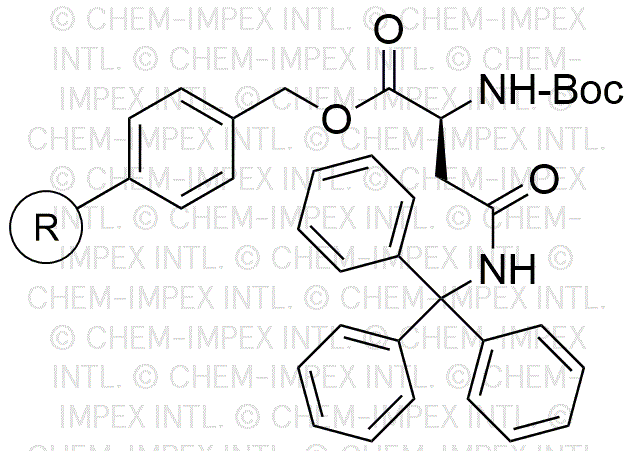Na-Boc-Ng-trityl-L-asparagine Merrifield resin is widely utilized in research focused on:
- Peptide Synthesis: This resin serves as a solid support for synthesizing peptides through the Merrifield method, allowing for efficient and scalable production of complex peptides.
- Drug Development: In pharmaceutical research, it is used to create peptide-based drugs, enabling the exploration of new therapeutic agents with targeted actions.
- Bioconjugation: The resin facilitates the attachment of peptides to other biomolecules, enhancing the development of bioconjugates for diagnostics and targeted therapies.
- Protein Engineering: Researchers utilize this resin to modify proteins, improving their stability and activity, which is crucial in enzyme development and biotechnology applications.
- Academic Research: It is a valuable tool in academic laboratories for studying peptide interactions and functions, contributing to advancements in molecular biology and biochemistry.
General Information
Properties
Safety and Regulations
Applications
Na-Boc-Ng-trityl-L-asparagine Merrifield resin is widely utilized in research focused on:
- Peptide Synthesis: This resin serves as a solid support for synthesizing peptides through the Merrifield method, allowing for efficient and scalable production of complex peptides.
- Drug Development: In pharmaceutical research, it is used to create peptide-based drugs, enabling the exploration of new therapeutic agents with targeted actions.
- Bioconjugation: The resin facilitates the attachment of peptides to other biomolecules, enhancing the development of bioconjugates for diagnostics and targeted therapies.
- Protein Engineering: Researchers utilize this resin to modify proteins, improving their stability and activity, which is crucial in enzyme development and biotechnology applications.
- Academic Research: It is a valuable tool in academic laboratories for studying peptide interactions and functions, contributing to advancements in molecular biology and biochemistry.
Documents
Safety Data Sheets (SDS)
The SDS provides comprehensive safety information on handling, storage, and disposal of the product.
Product Specification (PS)
The PS provides a comprehensive breakdown of the product’s properties, including chemical composition, physical state, purity, and storage requirements. It also details acceptable quality ranges and the product's intended applications.
Certificates of Analysis (COA)
Search for Certificates of Analysis (COA) by entering the products Lot Number. Lot and Batch Numbers can be found on a product’s label following the words ‘Lot’ or ‘Batch’.
Numéro de catalogue
Numéro de lot/série
Certificates Of Origin (COO)
This COO confirms the country where the product was manufactured, and also details the materials and components used in it and whether it is derived from natural, synthetic, or other specific sources. This certificate may be required for customs, trade, and regulatory compliance.
Numéro de catalogue
Numéro de lot/série
Safety Data Sheets (SDS)
The SDS provides comprehensive safety information on handling, storage, and disposal of the product.
DownloadProduct Specification (PS)
The PS provides a comprehensive breakdown of the product’s properties, including chemical composition, physical state, purity, and storage requirements. It also details acceptable quality ranges and the product's intended applications.
DownloadCertificates of Analysis (COA)
Search for Certificates of Analysis (COA) by entering the products Lot Number. Lot and Batch Numbers can be found on a product’s label following the words ‘Lot’ or ‘Batch’.
Numéro de catalogue
Numéro de lot/série
Certificates Of Origin (COO)
This COO confirms the country where the product was manufactured, and also details the materials and components used in it and whether it is derived from natural, synthetic, or other specific sources. This certificate may be required for customs, trade, and regulatory compliance.


